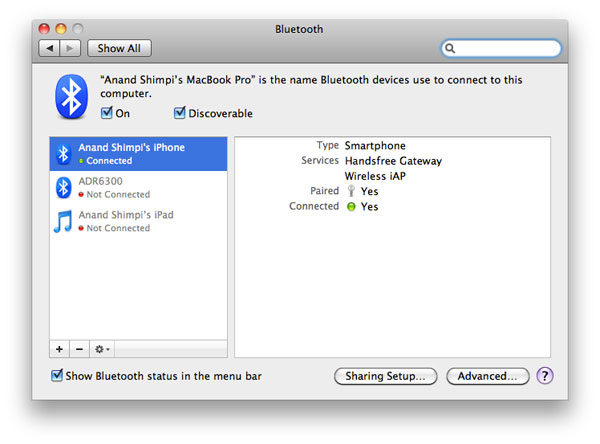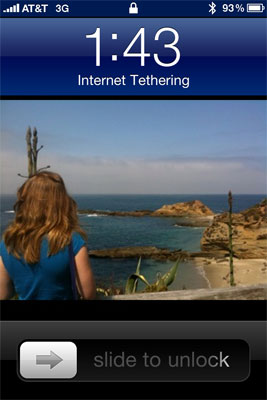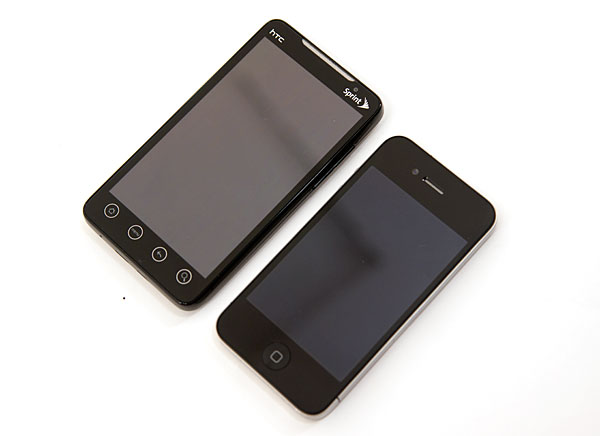Apple's iPhone 4: Thoroughly Reviewed
by Brian Klug & Anand Lal Shimpi on June 30, 2010 4:06 AM EST- Posted in
- Smartphones
- Apple
- iPhone 4
- Gadgets
- Mobile
Living with the 4
Thus far the majority of this article has focused on the technical details of the new iPhone both in its advancements and shortcomings, but what is it like to live with?
As I implied in the introduction, the 4 makes the previous iPhone feel very old. But in day to day use it doesn’t feel much different. It uses the same iOS that iPhone 3GS users get access to so with the exception of FaceTime and camera improvements, the iPhone 4 is functionally the same as its predecessor. That’s an important thing to keep in mind because to a 3GS owner it makes the iPhone not feel any different.

We've already covered iOS 4 extensively so there's no point in rehashing that here. The only new experience we have to add is our time with tethering.
The option to enable tethering is unfortunately buried in iOS 4's settings. You need to go into general settings, then network and then Internet tethering. You also need to either have Bluetooth enabled or be connected via USB to the computer you wish to tether.

You of course need to have tethering enabled on your plan, which you can't do from the settings menu. You either have to call AT&T or add the plan via attwireless.com. From there just connect to the 4 and you can use it as a modem. The phone can even be locked while tethered. Once enabled it ranges from a lifesaver to a total waste of money depending on AT&Ts coverage.

Getting used to the size of the new iPhone isn't hard at all. The device is a lot thinner which makes two handed portrait operation more strenuous especially if you're typing a lot on it. The 4 is going to be one great gaming device because holding it in landscape mode feels awesome. Overall I'd say the size feels right.
The glass everywhere is nice. It does make it impossible to quickly tell which side is front when you're fumbling around your pocket looking for it though. And I still feel like I'm going to drop and break the thing in no time at all. While not as slick as the 3GS' plastic, the stainless steel and glass aren't exactly the most grippy surfaces.
The higher res screen makes even sending text messages clearer. Everything is just so much more crisp.

Browsing the web is more pleasant as well, but tiny text is still tiny text regardless of how sharp the display is. You'll still need to zoom in on regular sites.
You do get used to the screen though. It's only when going back to the 3GS that the 4 feels new again. It's sort of like an SSD, you miss the retina display when it's gone.
The seat of the pants feel has definitely improved thanks to the A4. Although, I'd say its subtle. Web pages load quicker, animations are smoother. It's not perfect however. There are still some choppy animations and pauses from the scheduler giving too much CPU time to a hungry process. In general though, the phone feels like it was designed to run iOS 4 while the 3GS can get a bit overwhelmed at times.

The OS improvements, although not specific to the 4, are still lacking in two key areas. Apple still hasn't implemented a good notification system ala Android or webOS. I expected that update with iOS 4 but I guess we'll get it next year instead.
Secondly the multitasking interface is nice but still not quite perfect. I am still holding out for either an improved webOS or for Apple to do it's own take on the card system.
How does the 4 compare to Android? The same differences are still there. Currently there is no Android phone quite as sleek as the iPhone 4, although I expect that could change in less than a year.
The latest Android phones have had better cameras and higher resolution screens, so the iPhone 4 doesn't have as huge of an advantage there.
Apple still has the UI polish down pat. Scrolling is far smoother and performance more consistent, although I believe Google isn't far away from fixing this. The Froyo update alone does wonders to performance. If Google could fix the scrolling issues I'd say a number of iPhone users would for sure be fine with switching.

There is this more open, more configurable, more capable feel you get with Android that you don't with the iPhone. That can be both a positive and a negative. Android phones feel more like computers while iPhones have more of that appliance feel. It still boils down to personal preference, the 4 won't change that.










270 Comments
View All Comments
scarnie - Thursday, July 1, 2010 - link
See my article here: http://bit.ly/5pxjgkBasically, the iPhone 4 is about 33% faster than the 3GS (600MHz) and 25% slower than iPad (1GHz) putting it squarely at 800MHz.
Cheers,
Stu
heri16 - Thursday, July 1, 2010 - link
Since it has been confirmed that Apple would not be able to beat physics, the best way for them is to issue a firmware update to hide the signal loss in terms of bars (GASP!) . Since after-all, calls won't be dropped at one bar, why make us all worry?From my tests, attenuation by water-containing bodies is always a problem to RF. My best way around has been using micro-strip circular polarized antennas to reduce the effect. I've been using such antennas to cut 2.4Ghz signals through dense trees, which have "waterly" leaves. It also works better in rainy conditions compared to linear antennas.
(My tests shows reduction in attenuation by 70% in dbm units for my modded 2.4Ghz enterprise router through those same trees.) This will work since our hands/bodies are "waterly" too.
My suggestion to Apple to is have both thin circular-polarized micro-strip antennas embedded in the back surface, and linear polarized antennas at the sides, and diversity-RF controllers to get improved best-case and worst-case performance.
I'm not sure whether an iphone accessory maker can create the same fix through a paper-thin antenna plugged in.
heri16 - Thursday, July 1, 2010 - link
Here are some links to help understand the iphone RF fix.http://en.wikipedia.org/wiki/Circular_polarization
http://en.wikipedia.org/wiki/Microstrip_antenna
NordicNINE - Thursday, July 1, 2010 - link
I finished up work & school for the day and just popped down to relax. Brought up my favorite tech news site and started the recorded DVR shows. I pulled up this article and then the recording of the new Futurama started up.Xeeros - Friday, July 2, 2010 - link
Not to nitpick but The Incredible has 8GB internal PLUS the microSD which Verizon gives you a 2GB stick so it would be 10GB stock as they now package the SD card in the phone. Had a Launch unit and the refresher that says Droid on the box versuses the HTC incredible box. ONly difference was my store gave me a card for the 2GB and now its pre-packaged. To be honest most review sites that have it listed in comparison have it labeled this way, so probably not your fault.sporadic - Friday, July 2, 2010 - link
A question though:When you ran your PDF download tests were you using any encryption or was this on an open network?
dhvanii - Friday, July 2, 2010 - link
This is a great article on i4 antenna and DL reception. I have a few questions.1. if you take 1.5 MHz channel bandwidth, then the lowest signal strength measurable should be around -112 dBm. But this WCDMA and so if it is 4.5 MHz the lowest RSSI should be -107 dBm. Add to that a 4-6 dB noise figure and the lowest RSSI should be around -100 dBm. How is the device reporting -113 dBm for 3G ? Is that only for GSM reception where it is 200 KHz channel bandwidth and so theoretical lowest is around -120 dBm ?
2. How about UL ? What is the Max Tx Power of this device ? 23 dBm ? How is that affected by this antenna glitch. Radio link protocols requiring UL acks for DL packets will definitely get affected by this poor antenna performance if UL is also affected.
Thanks again for your detailed analysis.
navderek - Friday, July 2, 2010 - link
Well I'm glad we agree...to be honest I did not read the entire article, but only the section about the antenna issues with the handset.I did not see you bring up the point of CQI, nor did I see you mention that RSSI is really not a good measure for network coverage / quality (when used alone). Perhaps you've mentioned it in other articles, and if so a link to those would have been warranted for charities sake.
Have you ever considered writing up an article about how the air interface works? I think everyone would be much further ahead if they had a good basic understanding of the air interface and how the handset communicates with the BTS...especially now with so many networks competing it would put a little more power into the consumers hands to judge the quality of the network rather than rely on their silly marketing adds and crappy signal strength bar displays.
Finally, you said that at -107dB the iPhone4 "deals just fine" with it. Do you have data to back that up? What kind of data rates were you getting? I'd be surprised if you could even hit 1MB/s.
Just so you know, I work for TELUS Mobility in Canada. We have the first TRUE "all IP" network running in North America. We launched back at the end of 2009 with a 3.5G network. In my area we use NSN equipment and in practical use you can easily get sustained data rates greater than 10MB/s (downlink, theoretical = 21MB/s). We are also talking latencies of less than 50ms and almost no jitter....how did we do this? Well we are the only company in North America to have built the network from the ground up using IP transport all the way to the radios. We have fiber going to every single tower which serves only this 1 network (we have 2 others to manage as well, PCS / iDEN). :-) I'm not trying to prop-up my company or anything, but just giving a hint as to why other carriers such as AT&T have so many problems with their "patchwork" network which still most likely uses legacy copper circuits multiplexed and converted into IP packets...this puts significant strain on the core to keep up with the demands.
If people understood the air interface protocols in a general and basic sense at least they could judge the quality of this part of the network and then focus on looking into the other parts...I just find it frustrating that most people who don't understand how it works tend to give the network a "basket" rating based on simple RSSI measurements which does not really give much insight except as to how much radiation your standing in.
zmslink - Friday, July 2, 2010 - link
So the net effect is that iPhone 4 drops fewer calls then the 3GS despite losing as much as 24dB when held "incorrectly," but does that signal loss affect battery life much?davidcjones - Friday, July 2, 2010 - link
It is amazing how someone can do such detailed research to get to the bottom of this!Thanks for your hard work. Of course, I am distressed that people are so inclined to run to the courts to file class action suits before they actually investigate the issue in detail...
David Jones
Jericho, VT